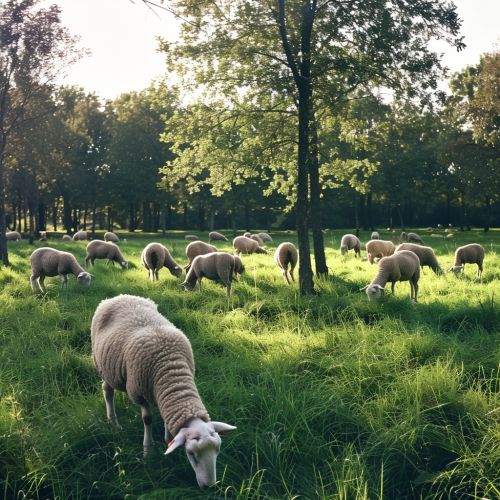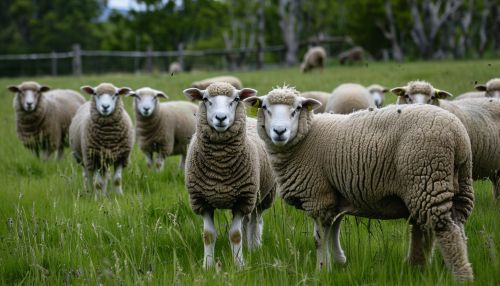Sheep
Overview
Sheep (Ovis aries) are domesticated ruminant mammals typically kept as livestock. They are one of the earliest animals to be domesticated for agricultural purposes, primarily for their wool, meat (lamb and mutton), and milk. Sheep are members of the Bovidae family and are closely related to goats. The study of sheep is known as ovine science, which encompasses various aspects such as breeding, genetics, nutrition, and health management.
Taxonomy and Evolution
Sheep belong to the order Artiodactyla, which includes even-toed ungulates. The genus Ovis includes several species, but Ovis aries is the most widely domesticated. The domestication of sheep is believed to have occurred around 10,000 years ago in the Fertile Crescent, a region in the Middle East. Genetic studies suggest that modern domesticated sheep are descended from the wild mouflon (Ovis orientalis).
Anatomy and Physiology
Sheep have a complex digestive system, characteristic of ruminants, which allows them to efficiently process fibrous plant material. Their stomach is divided into four compartments: the rumen, reticulum, omasum, and abomasum. This specialized digestive system enables them to extract nutrients from low-quality forage.
Sheep are covered in wool, a crimped fiber that grows continuously. Wool is highly valued for its insulating properties and is harvested through shearing. The fleece of sheep varies in quality and quantity depending on the breed.


Breeds
There are over 1,000 recognized breeds of sheep, each adapted to specific environments and purposes. Some of the most notable breeds include:
- **Merino**: Renowned for its fine wool.
- **Suffolk**: Known for its meat production.
- **Dorset**: Valued for both meat and wool.
- **Karakul**: Famous for its pelts.
Reproduction and Lifespan
Sheep are seasonal breeders, with ewes (female sheep) typically coming into estrus in the fall. The gestation period for sheep is approximately 147 days, resulting in the birth of one to three lambs. Lambs are usually weaned at around 8 to 12 weeks of age. The lifespan of sheep varies by breed and management practices but generally ranges from 10 to 12 years.
Nutrition and Feeding
Sheep are herbivores and primarily graze on grasses, legumes, and other forbs. Their diet can be supplemented with hay, silage, and grain, especially during periods of low forage availability. Proper nutrition is crucial for maintaining health, reproductive performance, and wool production. Mineral supplements, particularly those containing selenium and copper, are often necessary to prevent deficiencies.
Health and Diseases
Sheep are susceptible to a variety of diseases and parasites. Common health issues include:
- **Foot rot**: A bacterial infection causing lameness.
- **Scrapie**: A fatal neurodegenerative disease.
- **Internal parasites**: Such as gastrointestinal nematodes.
- **External parasites**: Including lice and mites.
Preventative health measures, such as vaccination, deworming, and proper management practices, are essential for maintaining flock health.
Economic Importance
Sheep farming is a significant agricultural activity in many countries. The primary products derived from sheep include:
- **Wool**: Used in textiles and clothing.
- **Meat**: Lamb and mutton are important sources of protein.
- **Milk**: Used to produce cheese and yogurt.
Sheep also play a role in sustainable agriculture by contributing to soil fertility through their manure and helping to manage vegetation.
Cultural Significance
Sheep have been integral to human culture and economy for millennia. They are often depicted in art, literature, and religious texts. In many cultures, sheep symbolize innocence, purity, and sacrifice.
See Also
References
- No references available.
